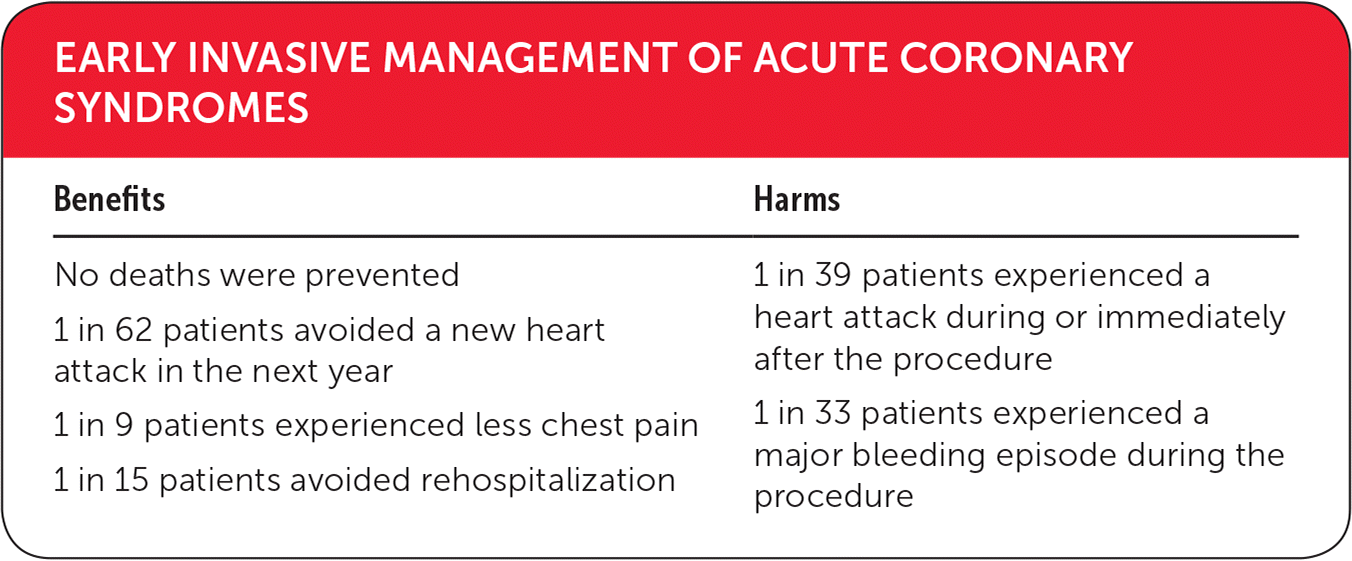
Am Fam Physician. 2018;98(11):online
Author disclosure: No relevant financial affiliations.


| Benefits | Harms |
|---|---|
| No deaths were prevented | 1 in 39 patients experienced a heart attack during or immediately after the procedure |
| 1 in 62 patients avoided a new heart attack in the next year | |
| 1 in 9 patients experienced less chest pain | 1 in 33 patients experienced a major bleeding episode during the procedure |
| 1 in 15 patients avoided rehospitalization |
Details for This Review
Study Population: Patients with unstable angina or acute non–ST-segment elevation myocardial infarction (NSTEMI)
Efficacy End Points: Death, myocardial infarction, angina symptoms, and rehospitalization at six- to 12-month follow-up
Harm End Points: Bleeding, periprocedural myocardial infarction, death
Narrative: Reperfusion therapy for acute ST-segment elevation myocardial infarction (STEMI) has been shown to be beneficial. However, there is controversy regarding the management of unstable angina and NSTEMI. Fowler and Conti coined the term unstable angina in 1971 for patients who did not meet the criteria for acute myocardial infarction or stable angina.1,2 The term may be outdated now with the increased sensitivity of cardiac troponins. Patients with unstable angina or patients in the “gray zone” of symptomatic ischemia can now be diagnosed as having NSTEMI.3 This Cochrane review4 updates the 2010 review5 of early invasive management for acute coronary syndrome that identifed five trials. That systematic review found a statistically significant reduction in myocardial infarction (2%) with the invasive strategy and concluded that an early invasive strategy was superior to a noninvasive strategy.5
In this updated Cochrane review,4 the authors added three new trials with a total of 1,099 participants to the meta-analysis. Therefore, the updated Cochrane review represents eight randomized controlled trials with a total of 8,915 participants randomized to an invasive strategy, whereby all patients undergo coronary angiography and revascularization (as necessary), or a conservative strategy in which medical therapy is used initially and patients are selected for cardiac catheterization only if there is evidence of persistent myocardial ischemia. Patients included in the studies were at least 18 years of age, had an episode of chest pain at rest, and had at least one of the following criteria: (1) electrocardiography changes including new ST depression, transient ST elevation (less than 20 minutes), or ischemic T wave inversions in at least two contiguous leads; (2) elevated cardiac markers; or (3) known coronary artery disease. Patients were excluded if they had persistent ST elevation, secondary causes of acute myocardial ischemia or cardiac biomarker elevations, severe cardiogenic shock or congestive heart failure, arrhythmias that required catheterization, refractory symptoms, coronary revascularization within the past 30 days, or intolerance to anticoagulation or antiplatelet therapy.
This new Cochrane review concludes that an early invasive strategy does not provide a mortality benefit (relative risk [RR] = 0.87; 95% confidence interval [CI], 0.64 to 1.18).4 However, invasive strategy reduced the rate of refractory chest pain (absolute risk reduction [ARR] = 11%; RR = 0.64; 95% CI, 0.52 to 0.79) and the risk of nonfatal myocardial infarction within a year (ARR = 1.5%; RR = 0.79; 95% CI, 0.63 to 1.00) compared with patients who were managed conservatively. The rate of rehospitalization was also reduced with an early invasive strategy (ARR = 6.7%; RR = 0.77; 95% CI, 0.63 to 0.94).
More complications were noted in the invasive group. There was an increase in periprocedural myocardial infarction (absolute risk increase [ARI] = 2.5%; RR = 1.87; 95% CI, 1.47 to 2.37) in the invasive management group as well as an increase in the risk of major bleeding events (ARI = 3%; RR = 1.73; 95% CI, 1.3 to 2.31). Increased risks of periprocedural heart attack and major bleeding caused by the procedure appear to offset any benefits in preventing future heart attacks. However, patients might benefit from the procedure simply from reducing chest pain or preventing rehospitalization.
Caveats: A limitation of the presented data is that when conservative therapy (ongoing pain or ischemia) was ineffective, patients underwent invasive angiography and stenting as necessary. This makes it difficult to assess whether invasive therapy is beneficial over conservative therapy alone. In addition, it introduces bias in the rates of rehospitalization. Patients who switch from conservative treatment to an invasive strategy are more likely to be rehospitalized.
The authors of the systematic review deemed the trials to have a high risk of performance-blinding bias. All studies were deemed to have low risk of attrition bias.
The updated Cochrane review4 added two trials on patients with an increased risk of mortality (the Italian Elderly ACS6,7 and LIPSIA-NSTEMI8 trials), which were not included in the 2010 Cochrane review5. The participants in the Italian Elderly ACS trial were all at least 75 years of age, which has been associated with increased rates of adverse effects.6,7 The LIPSIA-NSTEMI trial included participants who already had elevated troponin levels, and routine use of glycoprotein IIb/IIIa inhibitors may have contributed to increased adverse events with the invasive strategy.8 Inclusion of these high-risk populations may have caused the overall outcomes to be less favorable in both groups.
